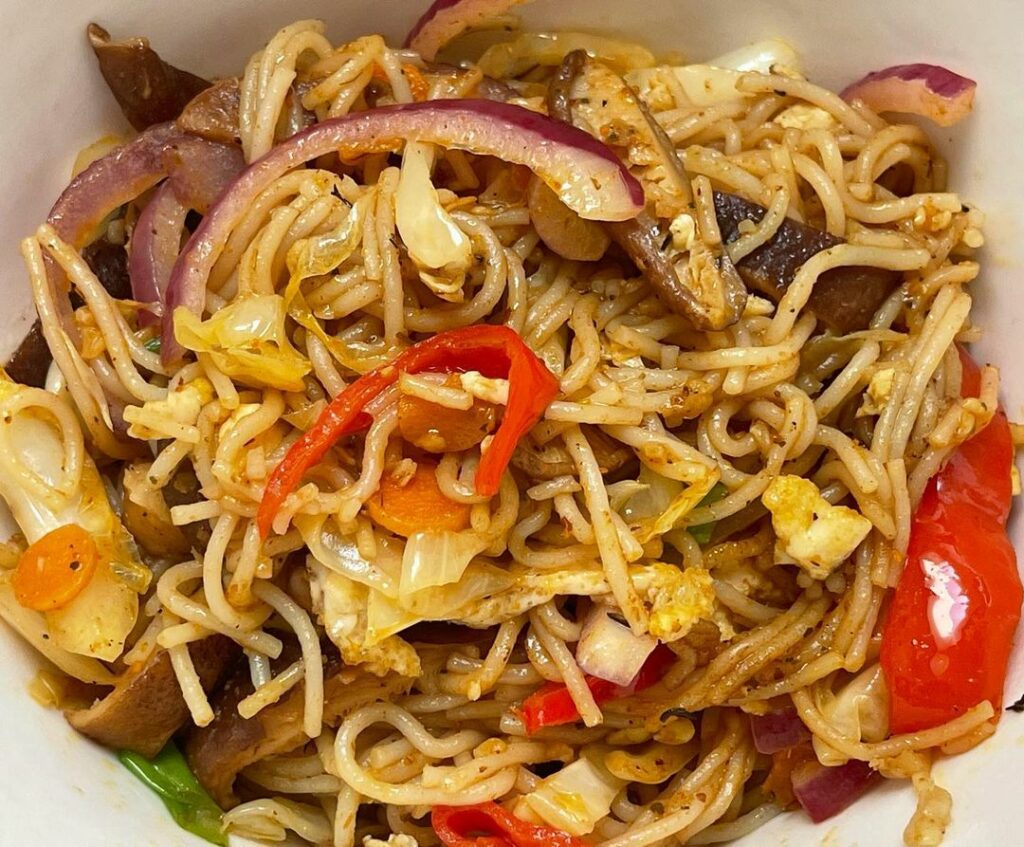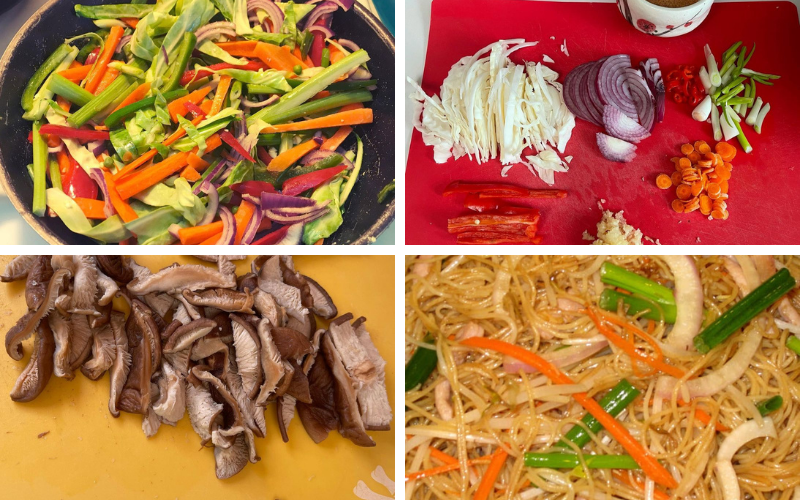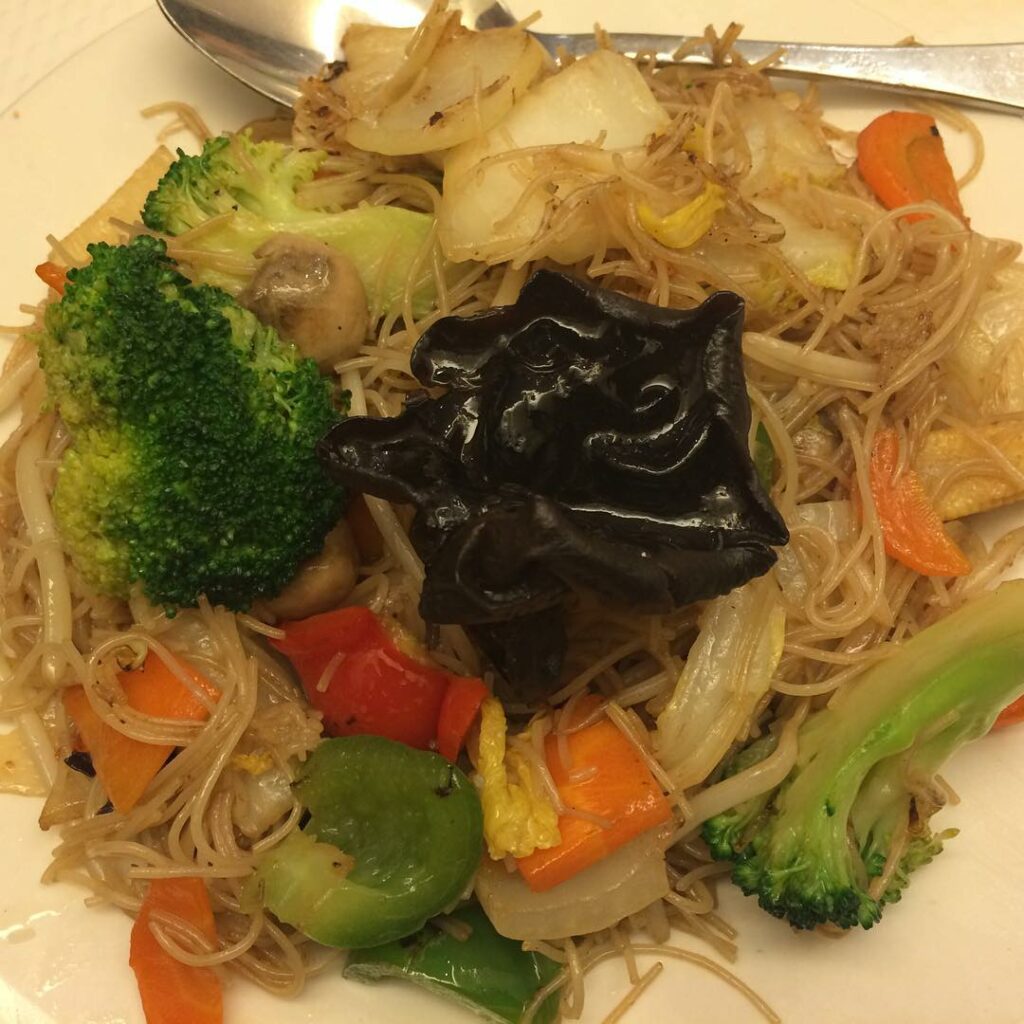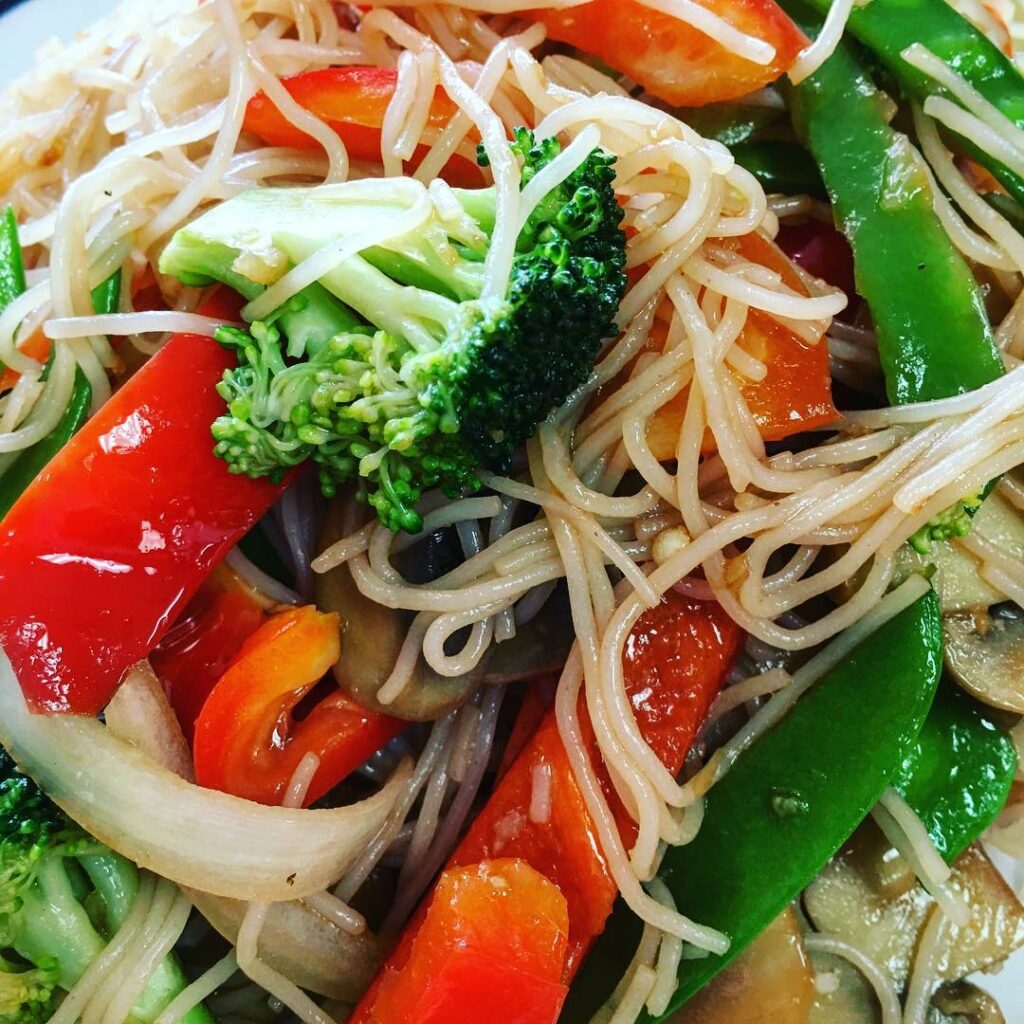Vegetable Mei Fun, a delightful and versatile dish, showcases the vibrant flavors and textures of a vegetable-forward twist on the classic Chow Mei Fun. With its colorful assortment of fresh vegetables, delicate rice noodles, and aromatic seasonings, Vegetable Mei Fun offers a delicious and healthy option for those seeking a vegetarian or plant-based meal.
Read also: Chow Fun Vs Mei Fun Difference Comparison
What is vegetable mei fun?

Vegetable Mei Fun is a variation of the popular Chinese dish called Chow Mei Fun, which typically features thin rice noodles stir-fried with a combination of meats, vegetables, and flavorful sauces. In this vegetarian version, the dish focuses on showcasing a variety of vegetables as the main ingredients.
The key components of Vegetable Mei Fun include:
- Noodles: Thin rice noodles are used as the base for the dish. These noodles are delicate and have a slightly chewy texture when cooked.
- Vegetables: The dish is loaded with an assortment of vegetables, with Napa cabbage being a prominent ingredient. Napa cabbage adds a mild sweetness and crunch to the dish. Other vegetables commonly used in Vegetable Mei Fun include charred broccoli, blistered red bell peppers (to mimic the color of char siu, a roasted meat commonly found in traditional Chow Mei Fun), and Chinese black mushrooms (also known as shiitake mushrooms) for their earthy flavor.
- Eggs: Extra fluffy eggs are incorporated into the dish to provide a protein source and add richness. They are typically scrambled and then mixed with the noodles and vegetables.
- Flavors: The flavors of Vegetable Mei Fun are inspired by the curry-laden Singapore Chow Mei Fun. While it may not be an authentic Singaporean dish, the vegetarian version still draws on the bold and aromatic flavors commonly associated with Singaporean cuisine. The dish may feature a combination of spices, such as curry powder or paste, soy sauce, garlic, ginger, and other seasonings to add depth and complexity to the flavors.
Also read: Cantonese Chow Mein (15 min. Recipe)
Vegetable mei fun recipe

Before starting the vegetable mei fun recipe, ensure that all the ingredients are prepped and ready for cooking. Stir-frying is a quick process, so it’s important to have everything within reach.
Cooking note
- Yield: 4 servings
- Prep Time: 15 minutes
- Cook Time: 10 minutes
- Total Time: 25 minutes
- Course: Main Course
- Cuisine: Chinese
- Equipment:
- Wok or large skillet
- Strainer or colander
- Mixing bowls
- Sharp knife
- Cutting board
- Spatula or tongs
Ingredients
- 8 ounces (225g) rice noodles
- 2 tablespoons vegetable oil
- 3 cloves garlic, minced
- 1 tablespoon grated ginger
- 1 small onion, thinly sliced
- 1 medium carrot, julienned
- 1 bell pepper, thinly sliced
- 2 cups cabbage, thinly sliced
- 1 cup bean sprouts
- 3 tablespoons soy sauce (or tamari for gluten-free option)
- 1 tablespoon oyster sauce (optional, omit for vegan version)
- 1 tablespoon sesame oil
- 2 green onions, thinly sliced (for garnish)
How to make vegetable mei fun?
- Cook the rice noodles according to the package instructions. Drain and set aside.
- Heat the vegetable oil in a wok or large skillet over medium-high heat.
- Add the minced garlic and grated ginger to the hot oil. Stir-fry for about 30 seconds until fragrant.
- Add the sliced onion, julienned carrot, and bell pepper to the wok. Stir-fry for 2-3 minutes until the vegetables start to soften.
- Add the cabbage and bean sprouts to the wok. Continue stir-frying for another 2-3 minutes until the vegetables are tender-crisp.
- Push the vegetables to one side of the wok and add the cooked rice noodles to the empty space. Pour the soy sauce and oyster sauce (if using) over the noodles.
- Use a spatula or tongs to toss the noodles with the sauces and combine them with the vegetables. Stir-fry for an additional 1-2 minutes until everything is well mixed and heated through.
- Remove the wok from heat and drizzle sesame oil over the vegetable Mei Fun. Toss once more to evenly distribute the flavors.
- Serve the vegetable Mei Fun hot, garnished with sliced green onions.
How many calories in vegetable mei fun?
Vegetable Mei Fun nutrition facts and a well-balanced meal option, packed with essential nutrients and health benefits. Let’s explore the nutritional value of this delicious dish and how it contributes to a balanced diet.
Nutritional composition
Here is a breakdown of the approximate nutritional composition of Vegetable Mei Fun per serving:
| Nutrient | Amount Per Serving |
| Calories | 250-300 |
| Carbohydrates | 40-45 grams |
| Protein | 6-8 grams |
| Fat | 6-8 grams |
| Fiber | 4-6 grams |
| Vitamins and Minerals | Varies |
Is vegetable mei fun healthy?

Yes, Vegetable Mei Fun can be a healthy dish. By incorporating a variety of vegetables, it adds nutritional value to the meal. Vegetables are rich in vitamins, minerals, and dietary fiber, which are beneficial for overall health. Additionally, the absence of meat in this vegetarian version can make it lower in saturated fat and cholesterol compared to traditional Chow Mei Fun recipes that include meat. However, the overall healthiness of the dish also depends on the cooking method and the amount of added sauces or seasonings.
What to serve with vegetable mei fun?
Vegetable Mei Fun pairs well with a variety of complementary dishes and accompaniments. Here are a few suggestions for what you can serve with Vegetable Mei Fun:
- Stir-Fried Tofu: Add some protein to your meal by serving Vegetable Mei Fun with stir-fried tofu. Tofu provides a nice contrast in texture and adds a satisfying element to the dish.
- Steamed Vegetables: Steam a side of vegetables such as broccoli, bok choy, or snap peas. The steamed vegetables will complement the flavors of the Vegetable Mei Fun while adding more nutritional value to your meal.
- Spring Rolls: Serve Vegetable Mei Fun alongside crispy and flavorful spring rolls. These bite-sized appetizers will add an extra dimension of texture and taste to your meal.
- Asian Salad: Prepare a refreshing Asian-inspired salad with mixed greens, shredded carrots, cucumber, and a tangy sesame dressing. The fresh and crunchy salad will provide a refreshing contrast to the warm and savory Vegetable Mei Fun.
- Dumplings: Serve Vegetable Mei Fun with steamed or pan-fried dumplings. The dumplings can be filled with a variety of vegetable or tofu-based fillings, complementing the flavors of the Mei Fun.
- Kimchi: Add a spicy and tangy kick to your meal by serving Vegetable Mei Fun with a side of kimchi. The fermented cabbage and vegetables will provide a vibrant and flavorful addition to your plate.
- Fresh Fruit: Finish off your meal with a bowl of fresh sliced fruits, such as watermelon, pineapple, or mango. The natural sweetness and juiciness of the fruits will provide a refreshing and light ending to your Vegetable Mei Fun feast.
Variations of vegetable mei fun
There are several variations and customization options available for Vegetable Mei Fun. Here are a few ideas to add variety and personalize your dish:
- Protein Additions: Enhance the nutritional value of Vegetable Mei Fun by adding protein-rich ingredients such as tofu, tempeh, seitan, or edamame. These additions can provide a more satisfying and filling meal.
- Spicy Kick: If you enjoy spicy flavors, you can incorporate chili sauce, sriracha, or red pepper flakes into the stir-fry to add heat and depth of flavor to your Vegetable Mei Fun.
- Nutty Delight: For an extra crunch and nutty flavor, consider adding chopped peanuts, cashews, or sesame seeds as a garnish. These additions can provide a delightful texture contrast to the soft rice noodles and vegetables.
- Citrus Twist: Squeeze fresh lime or lemon juice over your Vegetable Mei Fun just before serving to add a bright and tangy flavor profile. The citrus juice can bring a refreshing element to the dish.
- Mushroom Magic: If you’re a fan of mushrooms, consider adding sliced shiitake, cremini, or oyster mushrooms to your Vegetable Mei Fun. Mushrooms add an earthy and savory taste that pairs well with the other ingredients.
- Bean Sprout Boost: Increase the amount of bean sprouts in your Vegetable Mei Fun to add more crunch and freshness to the dish. Bean sprouts have a mild and crisp texture that complements the soft rice noodles.
- Herbaceous Touch: Sprinkle chopped fresh herbs like cilantro, Thai basil, or mint over your Vegetable Mei Fun to add a burst of fragrance and herbaceous flavor. The herbs can elevate the overall taste and presentation of the dish.
Vegetable mei fun cooking tips

Select the right rice noodles: When shopping for ingredients, choose vermicelli rice noodles made only of rice and water. Avoid noodles that contain tapioca flour, bean thread, glass, or cellophane, as they can easily be confused. Look for rice noodles specifically made of rice and water.
Opt for dried shiitake mushrooms: Instead of fresh shiitake mushrooms, use dried ones for a more impactful flavor. Dried shiitake mushrooms have a concentrated taste and release flavorful mushroom water that can help loosen stuck-on noodles from the wok. Look for them in flat, vacuum-sealed packages at Asian or international markets, or in bulk bins at specialty stores. Choose ones with shorter stems and wide, fleshy caps. Keep in mind that thicker caps may take longer to reconstitute, but they offer extra-juicy and meaty bites.
Use a wok if possible: It is highly recommended to cook Vegetable Mei Fun in a wok. A wok provides better heat distribution and allows for proper tossing and stirring of ingredients. If a wok is not available, you can use a deep, extra-wide sauté pan or Dutch oven as an alternative. However, using a shallow pan can lead to sticking or burning, ingredients getting steamed instead of stir-fried, and the risk of ingredients flying out. Investing in a good wok is worthwhile due to its versatility and cooking advantages.
How to store and reheat vegetable mei fun?
To store Vegetable Mei Fun, allow the cooked dish to cool to room temperature. Transfer it to a shallow glass or plastic container with an airtight lid, ensuring a tight seal. Store the container in the refrigerator for up to 5 days.
When reheating Vegetable Mei Fun, fluff the noodles with a fork before proceeding. For microwave reheating, loosely cover the container with a damp paper towel and heat on medium until heated throughout. Alternatively, sauté the dish on medium heat in a pan until hot, adding a small amount of oil or water to prevent sticking. Steaming is another option: place the Vegetable Mei Fun in a steamer basket or dish and steam until hot.
FAQs
Can I use different types of vegetables in vegetable Mei Fun?
Certainly! You can absolutely use different types of vegetables in Vegetable Mei Fun based on your preferences and availability.
While there are traditional vegetables commonly used, such as carrots, bell peppers, cabbage, and bean sprouts, feel free to experiment and include vegetables like broccoli, snow peas, mushrooms, or any others you enjoy. The versatility of Vegetable Mei Fun allows for customization and personalization.
Is vegetable Mei Fun spicy?
As for the spiciness of Vegetable Mei Fun, it typically depends on the choice of seasonings and sauces used in the recipe. While the base recipe may not be inherently spicy, you can add heat by incorporating chili sauce, red pepper flakes, or fresh chili peppers. Adjust the level of spiciness to your liking, whether you prefer a mild or fiery kick.
Is vegetable mei fun gluten free?
Regarding gluten, traditional rice noodles used in Vegetable Mei Fun are gluten-free, making the dish suitable for those with gluten intolerance or sensitivity. However, it’s important to ensure that other ingredients, such as sauces or condiments, are also gluten-free.
Some variations or pre-made sauces may contain gluten, so it’s advisable to check labels or choose gluten-free alternatives to maintain a gluten-free Vegetable Mei Fun.
What kind of oil is best for cooking vegetable Mei Fun?
The best oil for cooking Vegetable Mei Fun is a high smoke point oil that can withstand the high heat required for stir-frying. Common options include vegetable oil, canola oil, peanut oil, or sesame oil.
These oils have neutral flavors and can handle the heat without burning, allowing the ingredients to be cooked evenly and imparting a pleasant taste to the dish. Choose an oil based on your preference and dietary needs.
How do I achieve the perfect texture for the rice noodles in vegetable Mei Fun?
To achieve the perfect texture for rice noodles in Vegetable Mei Fun, follow these steps:
- Start by soaking the rice noodles in warm water according to the package instructions. This helps soften the noodles and ensures they cook evenly.
- Drain the soaked noodles and add them to the stir-fry during the last few minutes of cooking. Overcooking the noodles can result in a mushy texture, so it’s important to add them towards the end.
- Use high heat and continuous tossing or stirring to cook the noodles quickly. Stir-fry them just until they are heated through and have absorbed the flavors of the other ingredients.
- Avoid over-soaking or overcooking the noodles, as they can become overly soft and lose their desired texture. Keep an eye on them during the cooking process to prevent overcooking.
How can I make vegetable Mei Fun more flavorful?
To make Vegetable Mei Fun more flavorful, you can try the following techniques:
- Increase the amount of seasonings like soy sauce, ginger, garlic, or other desired spices to enhance the overall taste.
- Experiment with different sauces or condiments, such as hoisin sauce, chili sauce, or sesame oil, to add depth and richness to the dish.
- Incorporate umami-rich ingredients like mushrooms, tamari sauce, or nutritional yeast to enhance the savory flavors.
- Add a squeeze of fresh lime or lemon juice just before serving to brighten the flavors.
- Consider marinating the tofu or protein option in a flavorful sauce before adding it to the stir-fry.
Is vegetable Mei Fun a good option for people with diabetes?
Vegetable Mei Fun can be a good option for people with diabetes, as it contains a balance of carbohydrates, protein, and vegetables. However, it’s important to be mindful of portion sizes and the choice of ingredients.
Opt for whole grain or low-carbohydrate rice noodles, include a variety of non-starchy vegetables, and control the amount of added sauces to manage blood sugar levels. Consulting with a healthcare professional or registered dietitian is recommended for personalized guidance.
Can I use frozen vegetables in vegetable Mei Fun?
Yes, you can use frozen vegetables in Vegetable Mei Fun. They can be a convenient option, especially when fresh vegetables are not readily available. Simply thaw the frozen vegetables before stir-frying or add them directly to the wok during cooking.
Keep in mind that frozen vegetables may release some moisture when cooked, so adjust the cooking time accordingly to prevent the dish from becoming watery. Additionally, fresh vegetables generally offer better texture and flavor, but frozen vegetables can still contribute to a tasty Vegetable Mei Fun.
Is vegetable Mei Fun a good dish for kids?
Vegetable Mei Fun can be a good dish for kids, as it combines colorful vegetables with flavorful rice noodles. It provides an opportunity to introduce children to a variety of vegetables and textures.
You can adjust the seasoning to suit their taste preferences, ensuring it’s not too spicy or overpowering. Additionally, involving kids in the cooking process can make it more enjoyable for them and increase their interest in trying new foods.
Can I use different types of sauces in vegetable Mei Fun?
Yes, you can use different types of sauces in Vegetable Mei Fun to vary the flavors. While soy sauce is commonly used, you can experiment with other sauces such as teriyaki sauce, sweet and sour sauce, or even a peanut sauce for a different twist.
Be mindful of the flavor profiles and how they complement the other ingredients. Adjust the quantities to achieve the desired taste.
How can I make vegetable Mei Fun more colorful?
To make Vegetable Mei Fun more colorful, you can try the following:
- Include a variety of vibrant vegetables such as carrots, bell peppers of different colors (red, yellow, or orange), purple cabbage, or colorful baby corn.
- Add sliced cherry tomatoes for a pop of red color.
- Incorporate greens like spinach or kale to bring in some vibrant green tones.
- Use colorful garnishes like chopped fresh herbs, such as cilantro or Thai basil, or sprinkle sesame seeds on top for added visual appeal.
- Consider using rainbow rice noodles or mixing different types of noodles, like combining white and brown rice noodles, for a visually interesting presentation.
Is vegetable Mei Fun a suitable option for people with food allergies?
Vegetable Mei Fun can be a suitable option for people with certain food allergies, but it’s important to consider individual dietary restrictions and allergens. Here are a few points to consider:
- Gluten Allergies: Traditional rice noodles used in Vegetable Mei Fun are gluten-free, making it suitable for individuals with gluten allergies or sensitivities. However, it’s crucial to ensure that all the ingredients, sauces, and condiments used are also gluten-free. Some variations or pre-made sauces may contain gluten, so it’s advisable to check labels or choose gluten-free alternatives.
- Soy Allergies: Soy sauce is a common ingredient in Vegetable Mei Fun. If you have a soy allergy, you can opt for soy sauce alternatives like tamari (gluten-free soy sauce) or coconut aminos, which are soy-free. Read product labels carefully to confirm that they are free from soy or any other allergens.
- Other Allergies: Vegetable Mei Fun can be a versatile dish, allowing for customization based on specific food allergies. You can choose vegetables that are safe for your allergies and adjust seasonings and sauces accordingly. Be cautious of potential allergens, such as peanuts, tree nuts, shellfish, or other ingredients that may be added as toppings or garnishes. It’s essential to read labels and be aware of cross-contamination risks if dining out.
- Cross-Contamination: When preparing Vegetable Mei Fun at home or ordering it from a restaurant, be aware of potential cross-contamination risks. Ensure that cooking utensils, cutting boards, and cooking surfaces are spotless to prevent allergen cross-contact.
It is always advisable to consult with a healthcare professional or a registered dietitian who can provide personalized guidance based on individual allergies and dietary needs. They can help you navigate food choices and make appropriate substitutions to ensure a safe and enjoyable dining experience.
Conclusion
At the end of the day, Vegetable Mei Fun is a delightful and healthy dish that brings together the vibrant flavors of fresh vegetables, fragrant spices, and delicate rice noodles. Originating from Chinese cuisine, this recipe has captured the hearts and palates of food enthusiasts around the world. Not only does Vegetable Mei Fun offer a satisfying and savory experience, but it also packs a nutritional punch with its abundance of vitamins, minerals, and fiber-rich ingredients.
By incorporating a variety of colorful vegetables, such as carrots, bell peppers, and snow peas, Vegetable Mei Fun provides a well-rounded and balanced meal. The flexibility of this dish allows for customization, enabling you to experiment with different vegetables, seasonings, and sauces to suit your taste preferences.
Whether you follow a vegan lifestyle, have specific dietary requirements, or simply appreciate a wholesome and flavorful meal, Vegetable Mei Fun is a fantastic option. It can be easily prepared in your own kitchen, offering a quick and convenient solution for a satisfying lunch or dinner.
More recipes